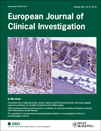Nicotinamide phosphoribosyltransferase and lipid accumulation in macrophages
Abstract
Eur J Clin Invest 2011; 41 (10): 1098–1104
Background Accumulation of modified low-density lipoprotein (LDL) in macrophages is a key event in all stages of atherogenesis. We have previously shown increased level of nicotinamide phosphoribosyltransferase (nampt) in symptomatic, compared to asymptomatic, atherosclerotic carotid lesions, primarily located to macrophages. Here we sought to investigate the regulation and effect of intracellular nampt in macrophages.
Materials and methods The expression of nampt was assessed by real-time PCR in THP-1 cells that was exposed to different pro-atherogenic stimuli. The effect of nampt on lipid accumulation was examined in phorbol myristate acetate-differentiated THP-1 and in primary monocyte-derived macrophages.
Results Our main findings were: (1) Nampt is increased during macrophage differentiation. (2) Tumor necrosis factor (TNF)α, oxidized (ox)LDL, and hypoxia increased nampt expression in macrophages, with further enhancing effect when these stimuli were combined. The effect of hypoxia seems to involve hypoxia inducing factor 1α. (3) Silencing of nampt increased lipid accumulation in macrophages as shown by increased protein levels of the lipid droplet marker adipose differentiation-related protein (ADRP). (4) A specific inhibitor of nampt enzymatic activity, increased ADRP and cholesterol levels in oxLDL stimulated macrophages, and enhanced the binding of acetylated LDL in these cells. (5). Nampt inhibition decreased the relative amount of cholesterol efflux in oxLDL-exposed macrophages.
Conclusions Our data suggest that the regulation of nampt in macrophages is linked to pro-atherogenic stimuli, potentially mediating counteracting effects on lipid accumulation and foam cell formation. These findings suggest a rather complex role of nampt in atherogenesis, potentially mediating both adaptive and maladaptive responses.




